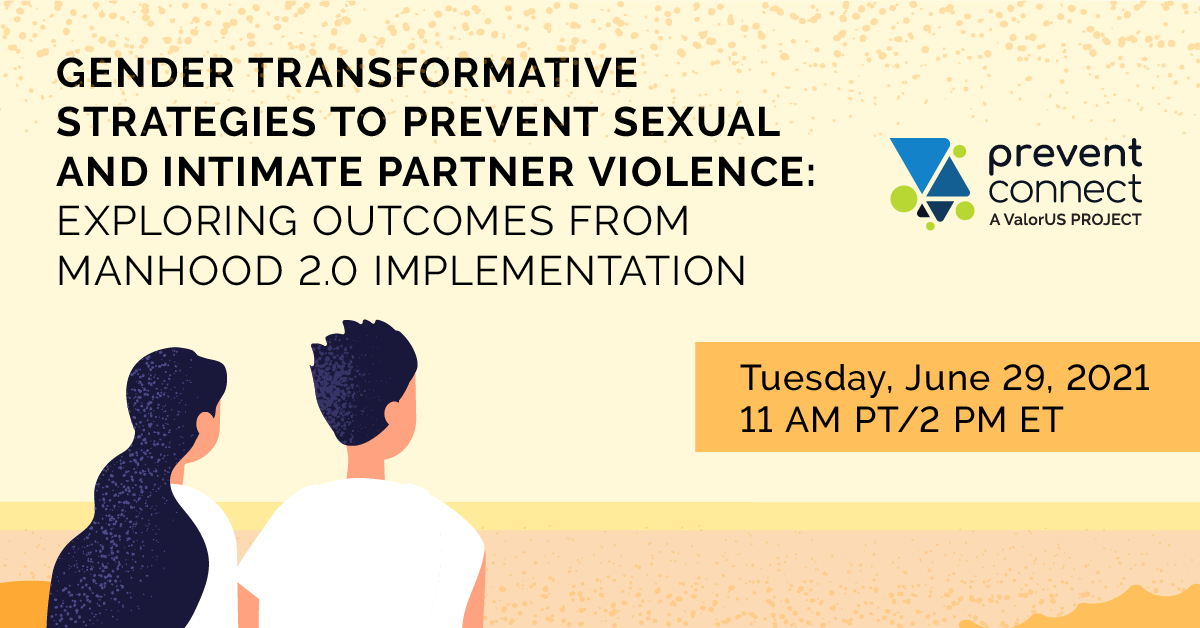Five Things to Know About Manhood 2.0 and Gender Transformative Strategies to Prevent Sexual and Intimate Partner Violence
PreventConnect is excited to host a web conference at the end of this month highlighting the research on, development and facilitation of Manhood 2.0, a gender transformative program to prevent sexual and intimate partner violence. Below are some key things to know about the program, the approach, and its impacts on preventing sexual and intimate partner violence.
What does a “gender transformative approach to prevent sexual and intimate partner violence” mean?
Here are a few trusted definitions of gender-transformative approaches and programs:
- From Promundo: “they transform gendered power relations and harmful gender norms”
- From Rutgers: “This approach examines, questions and transforms inequitable gender norms and power dynamics into positive values that directly enhance gender equality. This, in turn, improves access to health and rights for all.”
- From Hillebrand et. al, 2015: “transforming the power dynamics and structures that serve to reinforce gendered inequalities.”
Gender transformative approaches are connected to approaches in the CDC’s STOP SV and Preventing IPV technical packages, including promoting social norms that protect against violence, teaching safe and healthy relationship skills, engaging men and boys, and providing leadership opportunities for women and girls.
 What is Manhood 2.0?
What is Manhood 2.0?
From Promundo, the organization that developed Manhood 2.0: “Manhood 2.0 is a gender-transformative initiative to engage adolescent boys and young men in reflecting on the impacts of harmful gender norms in the United States.” Through activities like arts-based therapy, peer-to-peer discussion, and roleplaying, participants challenge harmful gender norms and societal expectations that increase the risk of sexual and intimate partner violence. The program seeks to advance sexual health and reproductive rights while preventing teen dating violence and LGBTQ+ bullying. Manhood 2.0 is a U.S. adaptation of Program H, which began its research in Brazil and is implemented in over 30 countries.
What does the research say about Manhood 2.0 and gender transformative strategies to prevent sexual and intimate partner violence?
Recent research finds that following participation in Manhood 2.0, rates of violence perpetration among participants decreased. The finding was similar in the control group, too, which attended a job readiness training. There could be a link and an opportunity to embed gender transformative programming into other youth-supportive programming, like job readiness training, to have the best reach and saturation for violence prevention strategies through community partnerships.
How do gender transformative strategies connect to racial justice?
Researchers with Manhood 2.0 recently published the results of their analysis of interviews with predominately Black male youths following Manhood 2.0 participation and found themes about the influence of race and racism on definitions of manhood that impact violence prevention. A quote from the discussion section summarizes the key findings and call to action:
Addressing racism in tandem with hegemonic masculinity is essential to honor the lived experiences of Black youths involved in gender-transformative programming and to challenge the violence the both ideologies promote.
What are implementation considerations for gender transformative violence prevention strategies?
The same research cited above also noted that the reason youth were comfortable and felt safe having these conversations about race, gender, and violence during Manhood 2.0 programming was because of the trust the leaders had established with youth, and because the program provided a space where participants could grow. The following quote highlights the ways they were able to gain this trust:
Addressing participants’ varied backgrounds, attitudes, and even past perpetration fostered authentic conversations. Participant buy-in allowed for deep, vulnerable discussion of previous experiences with racism and violence, endorsements of normative masculinity, as well as the articulations of complex and emotional masculinity. By embracing the internal tension within youths’ conceptions of masculinity, centering youths’ voices, and providing safe spaces for vulnerable discussion, programming that promotes authentic self-expression and leadership by youth offers a route to decouple masculine identities from violence.
The role of relationships and partnerships is not to be neglected in Manhood 2.0’s impact on preventing violence. Dr. Elizabeth Miller states, “To accomplish something like this requires nurturing community partnerships…In each of these neighborhoods, we worked with community members to facilitate the programs with an eye toward sustainability.”
Register now for Gender Transformative Strategies to Prevent Sexual and Intimate Partner Violence: Exploring Outcomes from Manhood 2.0 Implementation and tell us in the chat what gender transformative approaches you use in your work to prevent sexual and intimate partner violence. Revisit the web conference page following the live event for resources, slides, and a recording.
